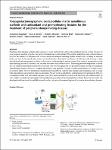Item Infomation
Full metadata record
| DC Field | Value | Language |
|---|---|---|
| dc.contributor.author | Nagarajan, Aishwarya | - |
| dc.contributor.author | Rizwana, Nasera | - |
| dc.contributor.author | Abraham, Michelle | - |
| dc.date.accessioned | 2023-10-06T02:57:16Z | - |
| dc.date.available | 2023-10-06T02:57:16Z | - |
| dc.date.issued | 2023 | - |
| dc.identifier.uri | https://link.springer.com/article/10.1007/s10856-023-06750-2 | - |
| dc.identifier.uri | https://dlib.phenikaa-uni.edu.vn/handle/PNK/9487 | - |
| dc.description | CC-BY | vi |
| dc.description.abstract | Peripheral demyelinating diseases entail damage to axons and Schwann cells in the peripheral nervous system. Because of poor prognosis and lack of a cure, this group of diseases has a global impact. The primary underlying cause of these diseases involves the inability of Schwann cells to remyelinate the damaged insulating myelin around axons, resulting in neuronal death over time. In the past decade, extensive research has been directed in the direction of Schwann cells focusing on their physiological and neuroprotective effects on the neurons in the peripheral nervous system. One cause of dysregulation in the remyelinating function of Schwann cells has been associated with oxidative stress. Tissue-engineered biodegradable scaffolds that can stimulate remyelination response in Schwann cells have been proposed as a potential treatment strategy for peripheral demyelinating diseases. However, strategies developed to date primarily focussed on either remyelination or oxidative stress in isolation. Here, we have developed a multifunctional nanofibrous scaffold with material and biochemical cues to tackle both remyelination and oxidative stress in one matrix. | vi |
| dc.language.iso | en | vi |
| dc.publisher | Springer | vi |
| dc.subject | Polycaprolactone | vi |
| dc.subject | graphene oxide | vi |
| dc.title | Polycaprolactone/graphene oxide/acellular matrix nanofibrous scaffolds with antioxidant and promyelinating features for the treatment of peripheral demyelinating diseases | vi |
| dc.type | Book | vi |
| Appears in Collections | ||
| OER - Khoa học Vật liệu, Ứng dụng | ||
Files in This Item:

